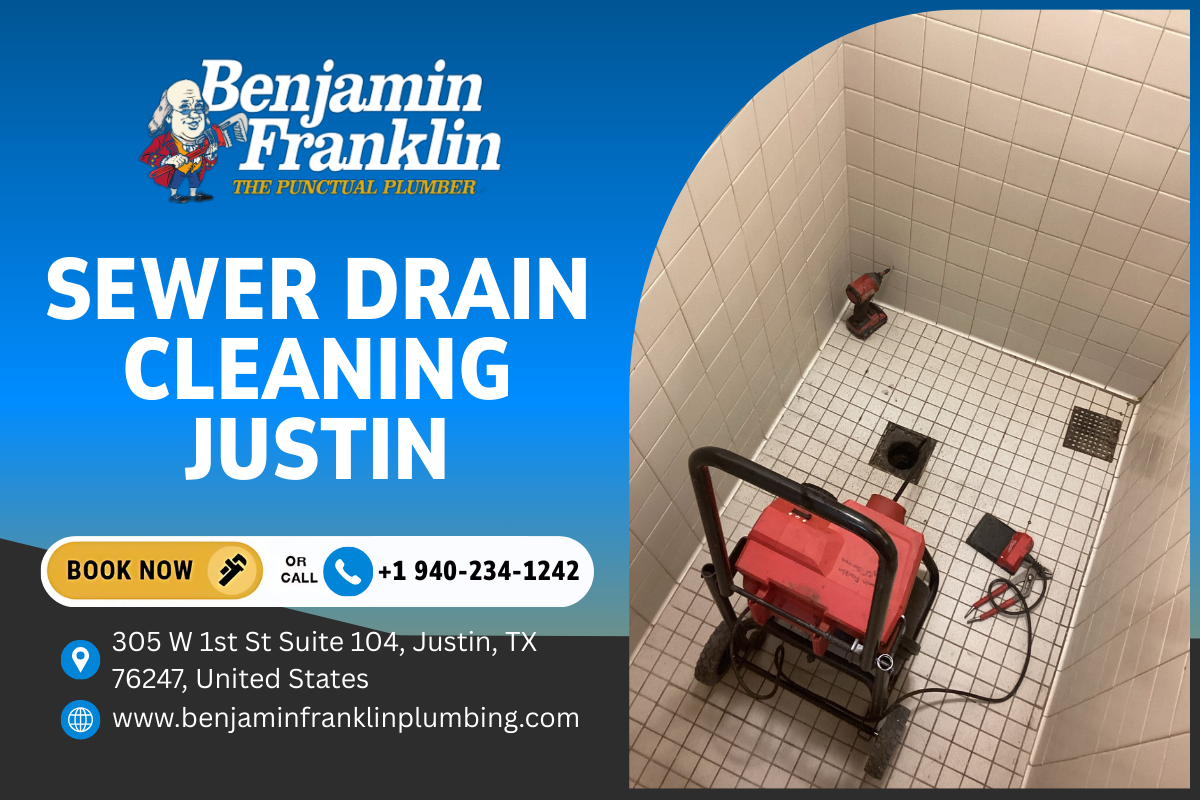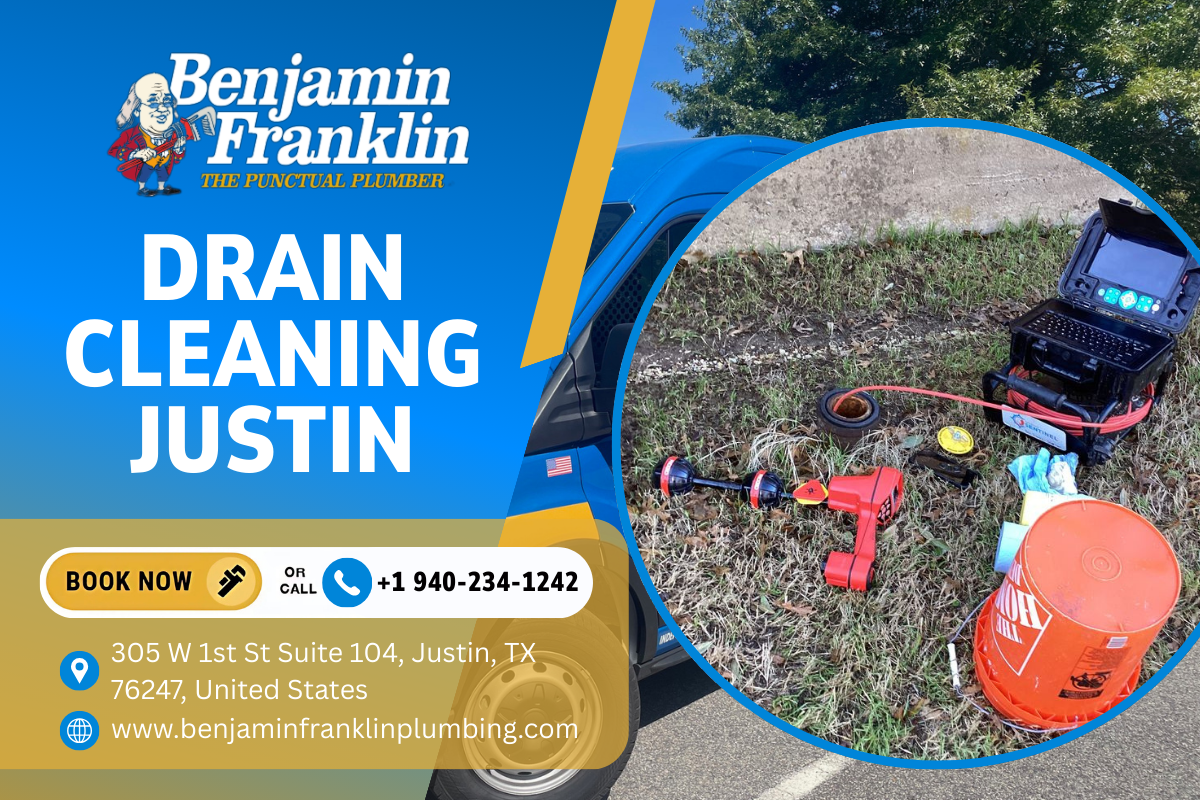


Plumbing doesn’t make the leasing brochure, but it can decide whether a building runs smoothly or bleeds cash. Property managers carry the responsibility for dozens or hundreds of fixtures that tenants treat like personal property, until they don’t. The difference between a calm Tuesday and a hallway full of wastewater often comes down to a predictable maintenance rhythm, a capable drain cleaning service, and a plan that doesn’t wait for the next clog to set the agenda.
This checklist isn’t about turning managers into plumbers. It’s about the questions, intervals, standards, and decisions that keep drains reliable across multifamily, mixed-use, retail, and light commercial properties. It also acknowledges realities: old cast iron stacks in one building, plastic traps in another, restaurants sharing a lateral with offices, and regional specifics such as clay sewer lines in older Texas neighborhoods. If you manage properties in or near Justin, Texas, you’ll see local nuances reflected as well, from soil movement to seasonal backups.
What fails first, and why that matters
Drains rarely fail all at once. They warn you in small ways: a shower that leaves a film of water for an hour, a floor drain that smells sour after a storm, a kitchen sink that gargles when the dishwasher runs. Those data points matter because they indicate where debris is accumulating and how close you are to a service call.
The most common failure patterns in residential and light commercial buildings look familiar. Bathroom drains accumulate hair and soap scum, then choke when a wad finally binds to a rough spot in older piping. Kitchen lines take on fats, oils, and grease that congeal into soft blockages, turning hard over months. Laundry lines face lint and occasional detergent overdoses that generate froth and slow drainage. Roof vents can clog with leaves or nests, causing fixtures to gurgle and traps to siphon. Main sewers collect everything from wipes to tree roots, particularly in properties with older clay or cast iron laterals.
Each category calls for a different tool and a different threshold for escalation. A property manager who knows when to authorize a light cable versus when to request hydro jetting service saves both time and pipes.
Building a schedule that works across unit types
You can’t set one calendar for every building, but you can use baseline frequencies and adjust based on age, tenant mix, and history. In garden-style complexes with plastic DWV and limited grease loads, annual mainline sewer drain cleaning may be sufficient. In mixed-use buildings with ground-floor restaurants, you may need quarterly mainline service with documentation tied to grease trap maintenance. For older single-stack high-rises, stack cleaning and camera inspections every one to two years pays dividends.
One manager I worked with in North Texas tied drain maintenance to seasonal turnover. They scheduled stack tops and roof vents to be checked every spring before heavy rain. Kitchen lines across problem stacks got a cable every six months, and the main sewer got a jet and camera annually. They recorded snags and lags in a simple log against apartment numbers, then shifted resources toward the lines that generated three or more slow-drain work orders per year. Over two leasing cycles, emergency calls after 10 p.m. dropped by half.
A practical checklist for daily, monthly, and annual attention
Routine makes emergencies rare. Here’s a workable sequence for most portfolios.
- Daily/weekly on-site observations: Have maintenance note slow drains, recurring odors, and gurgling when appliances run. In common areas, check floor drains for dried traps and pour water in if needed. Monthly spot checks: Verify that mechanical rooms with condensate drains are clear. Inspect grease trap service records in mixed-use buildings. Confirm that laundry room lint interceptors are in place and not bypassed. Quarterly targeted cleaning: Cable kitchen and laundry branch lines in known problem stacks. Test cleanouts for accessibility and label them if missing. Annual mainline service: Schedule sewer drain cleaning with a camera inspection for trend analysis. Document pipe condition, offsets, roots, and grease load by segment. After-event reviews: Following heavy storms, holiday cooking periods, or renovations, evaluate whether flow slowed or backups increased and adjust intervals accordingly.
Those five timeframes cover most buildings. Add seasonal roof vent checks where leaf load is significant, and consider biannual hydro jetting for food-service tenants whose grease traps trend out of compliance.
Choosing a drain cleaning service you can trust
Price matters, but pattern recognition and professionalism matter more. The best vendors see your property repeatedly, remember which cleanouts are buried, and advise you when a short-term fix would sabotage your long-term budget. When you vet providers, focus on capability and reporting. Ask what machines they carry in the truck: light and heavy cables, sectional machines, small-diameter jetters, large trailer jetters, and cameras with locators. Confirm they can produce a shareable video and an annotated map of issues.
Look for response times written into the service agreement. A 24/7 line with real dispatch beats voicemail roulette. For properties in the Denton County area, including Justin, local familiarity improves outcomes. A team that’s handled sewer drain cleaning in Justin will have a perspective on soil movement, common root intrusions near certain streets, and municipal cleanout expectations. If you manage multiple properties, request standardized reporting across sites so you can compare clog frequency and pipe condition.
Cable, jet, enzyme, or dig: using the right tool at the right time
For basic clogs, cabling works quickly and economically. A 3/8-inch cable with a retriever head clears hair in bathroom lines without scarring pipe walls. For tougher https://keeganaovz933.lowescouponn.com/from-drain-snaking-to-hydro-jetting-which-service-is-right-for-you kitchen lines, a 5/8-inch cable with a cutter head can carve a pilot hole through hardened grease, but it often leaves residue that narrows again in months. In those cases, a hydro jetting service provides a full scour, stripping material from the walls rather than tunneling a small path. The result lasts longer, particularly if followed by tenant education and enzyme maintenance.
Jetting comes with caveats. On brittle cast iron with heavy tuberculation, high-pressure water can shift flakes and expose holes. An experienced technician will throttle pressure, choose the right nozzle, and sometimes recommend a cable first to prevent pushing a clog into a fitting. For clay laterals, jetting can shave roots effectively, but a camera inspection afterward should confirm whether a spot repair or lining is needed. Improper jetting against a compromised joint can widen a gap and invite re-rooting.
Enzymes and bio-maintenance have a role. They don’t clear a current blockage, but they can slow grease build-up in kitchen stacks and help maintain long horizontal runs. Avoid caustic drain chemicals in shared plumbing; they can soften seals, pit pipe walls, and create safety risks for technicians who later cable the line. Educate tenants to report slow drains early rather than empty half a bottle of acid down a shared stack.
When repeated clogs recur at the same spot, dig deeper, figuratively and literally. Use a camera to understand why. A 30 percent dip in a section of cast iron will trap grease and lint, however often you clean it. A liner or sectional repair may cost more upfront than repeated service calls, but it stabilizes the budget and tenant experience.
Documentation that earns its keep
Good records outlive staff turnover and avoid repeated guesses. At minimum, record the date, line location, cleanout used, method (cable or jet), head/nozzle type, footage, clear notes on what came back (roots, grease, wipes), and whether a camera was used. Save videos with property and line identifiers, not generic file names that vanish in a shared drive.
This isn’t busywork. Documented sewer drain cleaning results inform replacement decisions. If three years of videos show increasing scale and offsets in the same 40-foot section, you have evidence to quote a lining project. If grease load drops after tenant outreach and a stricter grease trap schedule, you can reduce cleaning frequency and reallocate budget.
Tenant communication that actually changes behavior
Most clogs start at the fixture. Policies matter, but reminders tied to move-in and maintenance events work better than boilerplate. I’ve seen managers get results with short, specific messages: don’t pour turkey grease down the sink after holidays, let it cool, scrape into the trash, then wipe pans with a paper towel. In laundry rooms, install visible lint interceptors and signs that show a drain backup photo rather than a lecture. People respond to what they can visualize.
In student housing and high-turnover buildings, repetition is your friend. Three short messages per semester beat one long email in August. Ask your drain cleaning service to provide photos from your own property for authenticity.
What to stock on site, and what to leave to pros
Maintenance teams don’t need a truckful of plumbing equipment, but a few items prevent small issues from growing into after-hours emergencies. A wet-dry vacuum, a small hand auger for sink traps, spare P-traps and washers, enzyme packets for kitchen lines, trap primers or primer checks for floor drains, and test balls for quick isolation go a long way. For multi-story buildings, a basic inspection camera helps diagnose without dismantling fixtures, though you’ll still want vendors for deep runs and sewer mains.
Avoid the temptation to snake main lines with undersized equipment. I’ve seen resident managers push a small cable 40 feet into a 4-inch main and cork the blockage into a tee, turning a slow drain into a building-wide backup. When the main slows, call your vendor promptly and keep tenants in the loop. Fast, honest updates mitigate frustration.
When hydro jetting pays for itself
Hydro jetting isn’t a hammer for every nail. It shines where grease and sludge line the walls, where cabling has become a monthly ritual, or where root shaving requires a thorough clean before applying a sealant or scheduling a line repair. Restaurants and food halls that share laterals with residential units are prime candidates. If you manage properties in or near Justin, calling a local hydro jetting service during off-hours can clean the line without disrupting daytime business and traffic.
Track results. If jetting extends time-between-clogs from two months to nine, you have a defensible maintenance interval. If you see no improvement, cameras may reveal a sag or misaligned joint that no amount of cleaning will cure.
Working with older piping: cast iron, clay, and mixed materials
Older buildings are honest about their age if you listen. Cast iron stacks talk through pinhole leaks, rust staining, and increased scale in camera footage. Clay laterals speak through root matting and joint offsets. PVC tells you little until it cracks from ground movement around a poorly bedded run.
In mixed systems, transitions are the weak points. A clay-to-PVC coupling might be off by a few degrees, catching debris over time. Ask your drain cleaning service to note transitions and check couplings when possible. In North Texas soils, seasonal swelling and shrinking can move joints. If the same offset reappears and grows in successive videos, plan for a sectional dig and a proper bed rather than a fourth cleaning.
Emergency playbook: from first call to clear drain
When a tenant calls after hours about water on the floor, steps matter. Talk them through shutting off nearby fixtures. Ask whether the water is clear or foul to prioritize biohazard precautions. Direct them to avoid using other drains if a mainline backup is likely. Notify adjacent units proactively if the affected stack serves multiple apartments.
Dispatch your vendor with the right context: fixture, stack, floor, time symptoms began, whether a washing machine or dishwasher was running, and how far previous blockages were found in that line. Clear access saves time. If the cleanout is in a locked closet, provide a code or meet the tech. A 20-minute delay can turn a manageable spill into an insurance claim.
After the line is open, document the incident, pursue drying and sanitizing quickly, and schedule a preventive follow-up if the blockage source suggests recurrence. If wipes caused the clog, communicate respectfully to tenants, and consider signage specific to that stack.
Budgeting smart: smoothing costs across the year
Emergencies spike budgets. Predictable maintenance flattens them. Bundle routine drain cleaning services with other scheduled work like HVAC filter changes and fire inspections to consolidate access and reduce tenant disruption. Negotiate volume pricing for portfolios, but tie payments to deliverables such as camera footage and condition reports.
In markets like Justin, where vendors often serve a wide geographic area, ask about travel charges and see if combining service across nearby properties lowers mobilization costs. For example, scheduling sewer drain cleaning in Justin on the same day at two properties a mile apart can trim a trip fee. Capture those savings in a simple spreadsheet against your service log to prove the strategy’s value.
Selecting local expertise: when proximity adds value
A team that regularly handles drain cleaning in Justin will navigate local building codes, utility mark-out practices, and common failure points faster than an out-of-area outfit. They’ll know how quickly the city responds to a municipal main concern, which can matter if your building’s mainline is clear but the street lateral is not. In my experience, local vendors also tend to have better relationships with inspectors and can coordinate permits or line locates more efficiently.
If you advertise units in Justin or manage a mix of single-family rentals and small commercial spaces there, consider a standing relationship with a provider who can handle everything from clogged drain repair in a single bathtub to sewer drain cleaning across a strip center on a Saturday morning. Confirm they offer both routine drain cleaning service and after-hours response, and that their reporting will slot neatly into your existing maintenance software.
The human factor: training on-site staff
Equip maintenance staff to triage effectively. They should be comfortable removing a trap, spotting a collapsed ferrule, and reinstalling a P-trap without over-tightening. They need to recognize red flags that demand a vendor: repeated backups in multiple fixtures, sewage in floor drains, or gurgling that suggests vent blockage. Basic PPE training matters. Wastewater is a biohazard; provide gloves, eye protection, and a safe cleanup kit for small spills.
Teach staff to preserve evidence for diagnosis. When a cable retrieves roots or fabric wipes, have them photograph the debris next to a tape measure and attach the image to the work order. Small habits like that sharpen your vendor’s next move and improve preventive planning.
A concise contractor checklist you can hand to your team
- Coverage: 24/7 live dispatch, written response-time commitments, and clear after-hours rates. Capability: Cable and hydro jetting service, camera and locator, root cutting, and the ability to provide sewer mapping. Documentation: Same-day service notes, video links, and actionable recommendations with photos or footage. Safety and care: Protective measures for flooring and units, containment for wastewater, and insurance certificates on file. Local knowledge: Experience with drain cleaning services in Justin or your target area, plus references from similar properties.
Tape that near the maintenance desk. It keeps vendor selection consistent even when staff changes.
When repair is smarter than another cleaning
There’s a point where another pass with a cable or jetter is just buying time. Use your logs and videos to spot it. Three or more mainline clogs at the same footage in a year, repeated slowdowns after every holiday, or new evidence of structural damage on camera are signals to get repair quotes. You may choose between sectional repair, cured-in-place pipe lining, or full replacement depending on depth, access, and tenant disruption. Factor in lifecycle costs and the revenue impact of downtime.
If you opt for lining, coordinate closely. Line after a thorough clean and camera survey to confirm dimensions and host pipe integrity. Communicate drying times and access requirements to tenants. If you manage retail, schedule during off-peak hours and place temporary signage that minimizes customer anxiety.
Local note: clogged drain repair in smaller markets
In smaller markets such as Justin, clogged drain repair and service capacity can tighten during peak seasons. Plan ahead for fall and winter when grease loads rise and holiday cooking stresses kitchen lines. Contract a drain cleaning service in Justin before you need them. If you manage multiple properties, consider a rotation schedule so the vendor can predictably allocate crews. That relationship often pays off when you need a same-day sewer drain cleaning in Justin after an unexpected surge.
Bringing it all together
Effective drain management blends routine, responsiveness, and a record that tells the truth. Choose a vendor who can cable quickly, jet when it extends life, and show you what the camera sees. Build a schedule that reflects your buildings, not a generic template. Train staff to spot early signs, stock the right on-hand tools, and know when to escalate. Communicate with tenants in practical, visual terms, especially around grease, wipes, and lint. And if you operate around Justin or similar communities, leverage local expertise for faster fixes and better coordination.
Most of all, read your own data. The service log isn’t paperwork; it’s a map. Follow it, and drains become background noise instead of headline emergencies. When the inevitable clog appears, you’ll have the context to clear it fast, the judgment to choose the right method, and the foresight to prevent the next one.